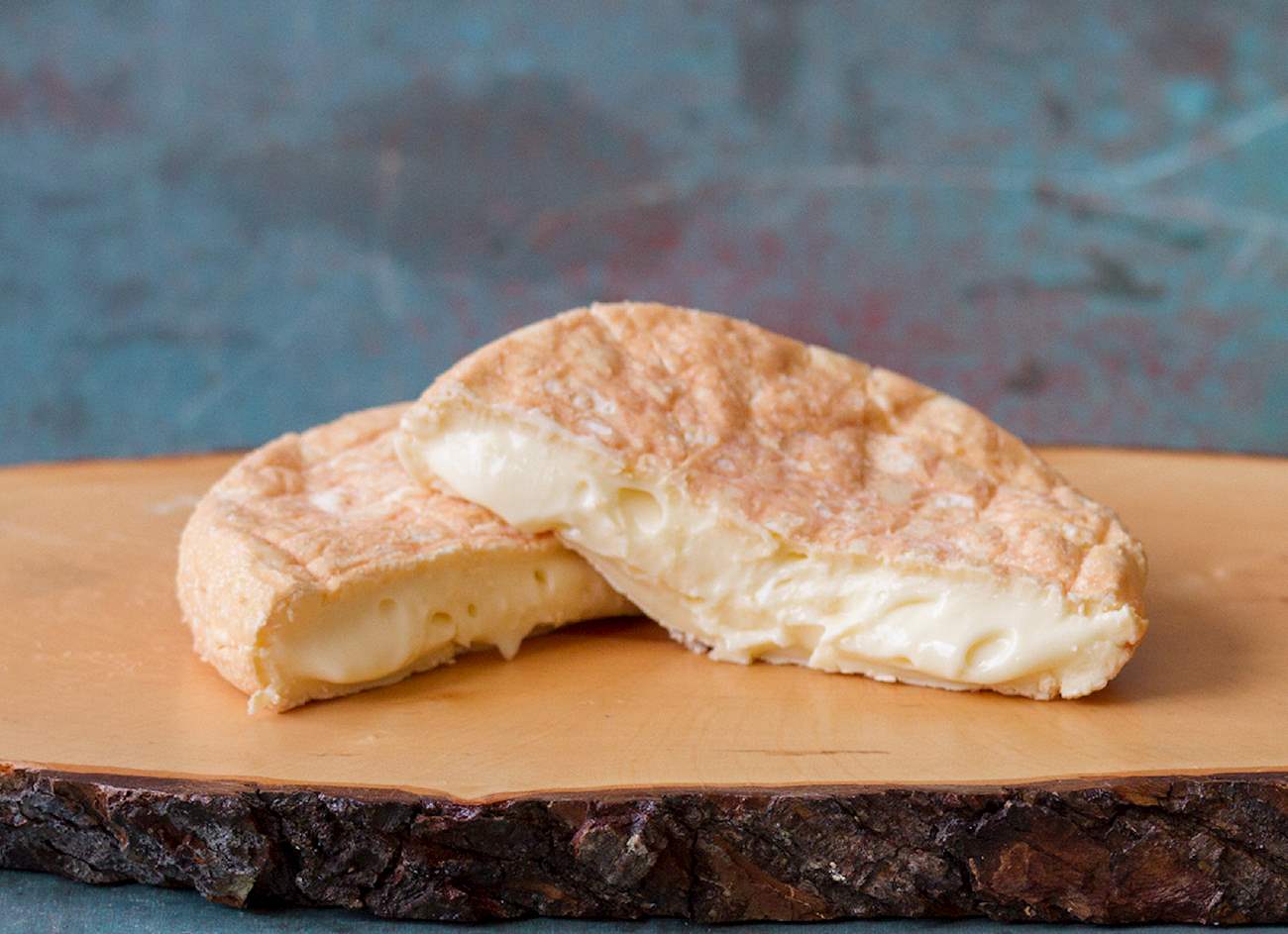Bijou is an American cheese hailing from Vermont. The cheese is made from pasteurized goat's milk and it's left to age for 30 days. During the maturation period, Bijou (jewel in French) forms a wrinkly mold-ripened rind with a sweet and yeasty aroma.
Underneath it, the texture is smooth and creamy. The flavors are tangy, sharp, yeasty, clean, milky, and sweet, with hints of hazelnuts and flowers. It's recommended to serve this small hand-shaped button of cheese with pickled cherries, pancetta, fig jam, and roasted hazelnuts.
Willoughby is an American semi-soft cheese produced in Vermont by Jasper Hill Farm. The cheese is made from pasteurized cow's milk and it has a washed rind. Underneath it, the texture is open, creamy, gooey, and buttery. The aromas are milky and herbal with hints of onions and roasted beef, and the flavors are fruity, milky, herbaceous, pungent, and savory.
It's recommended to use it in a tartiflette – broil the cheese over roasted potatoes, lardons, and leeks, then pair it with a glass of Mondeuse. Other pairings include potato chips, pickles, and walnut Dijon mustard.
Moses Sleeper is an American cheese produced in Vermont by Jasper Hill Creamery. Made from pasteurized cow's milk, it was inspired by the classic French Brie. Underneath its thin bloomy rind, there is a gooey texture with a milky aroma.
After 6 to 12 weeks of aging, the flavors become rich and nutty, with hints of cauliflower and fresh cream. There's a bright and clean finish with hints of white mushroom aroma. It's recommended to serve Moses Sleeper on a cheeseboard with baguettes, pickled carrots, or country-style meat spreads.
Pair with
Harbison is an American cheese that's produced in Vermont, at Jasper Hill Farm. It is made from cow's milk and has a bloomy rind. The cheese is traditionally wrapped in strips of spruce. It has a creamy and soft texture, the aromas are fruity, rich, floral, and mushroomy, while the flavors are best described as sweet, woody, and lemony.
The cheese is named after Anne Harbison, who originally contributed to its production. It is recommended to serve Harbison with baguettes, mostarda, and barrel-aged sour beer.
Pair with
Cabot Clothbound is an American type of Cheddar cheese hailing from Vermont, where it's produced as a special batch of Cabot Creamery and Jasper Hill Farm. The cheese is made from pasteurized cow's milk and it's aged for 10-15 months in cellar vaults.
After it comes to the cellars, the cheese is coated in lard and wrapped in a cloth. Underneath its natural rind, the texture is flaky and crumbly. The aromas are nutty, while the flavors are savory, tangy, and caramel-like. It's recommended to serve Cabot Clothbound with chestnut honey, cold cuts, or apple jelly.
Oma is an American cheese produced on Jasper Hill Farm in Vermont by the Von Trapp family (yes, the descendants of the family from The Sound of Music). The cheese has a washed rind and it's made with raw milk coming mostly from Jersey cows.
The body is soft and supple, yet never runny. The aromas are nutty and earthy, while the flavors are rich, creamy, meaty, barnyardy, pungent, and slightly sweet, with notes of chocolate, butter, and cured meat. It is recommended to pair this cheese with Belgian ales, IPA beer, and fig jam.
Bayley Hazen Blue is an American blue cheese produced by Jasper Hill Farm in Greensboro, Vermont. The cheese is made from raw cow's milk and it has a natural rind. It's named after an old military road that was commisioned by George Washington.
The recipe for this cheese was developed by altering the aging process and the shape of a Devon Blue recipe. The texture of Bayley Hazen Blue is dense, firm, and slightly dry, yet creamy and fudge-like, with blue veins running throughout it.
TasteAtlas food rankings are based on the ratings of the TasteAtlas audience, with a series of mechanisms that recognize real users and that ignore bot, nationalist or local patriotic ratings, and give additional value to the ratings of users that the system recognizes as knowledgeable. TasteAtlas Rankings should not be seen as the final global conclusion about food. Their purpose is to promote excellent local foods, instill pride in traditional dishes, and arouse curiosity about dishes you haven’t tried.



